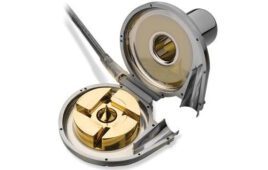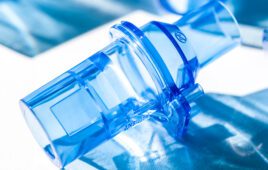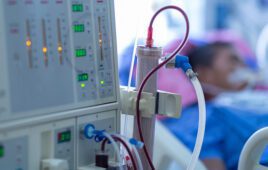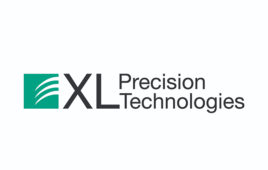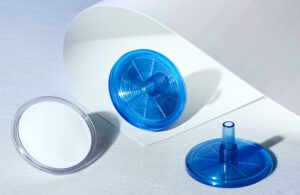
Syringe filters contain thin membranes that, if damaged during assembly, would render them useless. [Photo courtesy of Emerson]
Emerson officials think their PulseStaking offering provides a new option for welding the small, delicate structures found in filtration parts.
David Devine, Branson Welding and Assembly, Medical at Emerson
Technology and market demand are pushing designers and manufacturers to create medical devices that are ever smaller and more compact. The miniaturization trend is especially true of wearable devices used for drug delivery and patient monitoring. Assembling these plastic components, especially those with tiny filters that are frequently used in wearable devices, presents special challenges.
There are plenty of options for joining plastics, including ultrasonic welding, laser welding and staking and swaging processes that use ultrasonics or thermal technology. However, increasing miniaturization means that the parts to be assembled can be quite fragile and require the utmost care to prevent damage during welding or staking.
The filter media used in medical applications — typically made of polymers such as nonwoven polypropylene (PP) or polyethylene terephthalate (PET) — is usually sealed in a plastic frame or housing. While a larger device might accommodate filters that are an inch or more in diameter and 0.010 in. or more thick, the structures in wearables might be only 0.1–0.25 in. diameter and 0.005 in. or less thick. Most manufacturers would use ultrasonic welding if they could because it is fast, controllable and economical. However, the vibration it introduces may, in some cases, damage thin or fragile filter membranes. Even the equivalent of a pinhole would render the filters worthless.
To avoid damage, manufacturers of miniature filters and similar products seek alternatives to ultrasonics and increasingly considering thermal processes. It’s possible to design thermal tooling to apply heat and pressure around the entire circumference of a filter, bonding it to its housing in one step. Since thermal sealing is a nonvibratory process, it eliminates the risk of creating pinholes in the filter. The result is a high-quality seal.
Traditional steady state thermal sealing works OK in this regard. A manufacturer can produce thermal seals relatively quickly and at low cost, without the need for labor-intensive mechanical fastening, expensive adhesive fastening processes or the vibration of ultrasonics. But the process has its pitfalls in terms of cycle-to-cycle repeatability and process control. As designs evolve and more delicate components get assembled into the newest devices, manufacturers have found that thermal staking has some technical and control limitations.
A newer approach from Emerson, called PulseStaking, addresses many of these concerns. PulseStaking technology has been demonstrated to perform as well as or better than existing steady state thermal processes, and it is readily applicable for even the most delicate filter applications. It can work with multiple, closely spaced features on geometrically complex parts, including those with otherwise tricky angles and planes, and can create bonds on a wider range of plastics than traditional heat staking.
The PulseStaking cycle

Equipped for both heating and cooling, PulseStaking tips precisely manage tip and seal temperature until each seal is completed. [Illustration courtesy of Emerson]
This sequence of operations is much more controllable than that of a conventional thermal unit. In steady state thermal sealing, the tool is always energized, wasting heat energy and creating a larger carbon footprint. Beyond that, the staking process is never truly at a steady state. Each cycle draws heat out of the tool, which then needs to be restored before the next cycle. If sufficient reheating time is not built into the process, the weld temperature can vary, and one or two degrees can mean the difference between a good part and scrap.
In PulseStaking, on the other hand, tips go through a cycle of multiple heating, cooling, and pause or “dwell” intervals to prevent overheating and precisely manage tip and seal temperature until each seal is completed. Thus, cycle consistency does not rely on the temperature of the tool at the start of the cycle.
Automating manufacturing
The volumes associated with most medical devices, including wearables, are often in the hundreds of millions. Consequently, manufacturing lines are likely to be highly automated. Medical applications — like sealing filter media into a housing for a wearable medical device — typically involve complex manufacturing processes. After the filter seal, it is likely that there will be downstream testing, such as a machine-vision quality check. Ultimately, there will be additional processes to install the filter element into the larger component. Therefore, cycle consistency and temperature control become critical to the efficiency and repeatability of any high-speed multistep process. Variability in the sealing process will result in increased scrap and risk of a defective product, in addition to increased cycle times.
Automation also can require customizing the PulseStaking process to a specific application. Heating tips are available in many standard and custom shapes, and can be operated singly or — if required by production and cycle times — densely grouped into larger tools that can perform multiple operations at once. In addition, the localized heating characteristics of each tip, as noted above, enable sealing operations on complex or angled surfaces, in close proximity to heat-sensitive components such as printed circuit boards, and can even reach into deep cavities or other difficult-to-access areas without the risk of unintended radiant heating, even if tooling or tips pass very close to nontarget surfaces or heat-sensitive components.
As medical devices continue to evolve, becoming more complex and more compact, joining technologies that can accommodate tiny, thin and delicate components like filter elements become ever more important.

David Devine is business development manager, Medical, Branson Welding and Assembly at Emerson. [Photo courtesy of Emerson]
The opinions expressed in this post are the author’s only and do not necessarily reflect those of MedicalDesignandOutsourcing.com or its employees.

